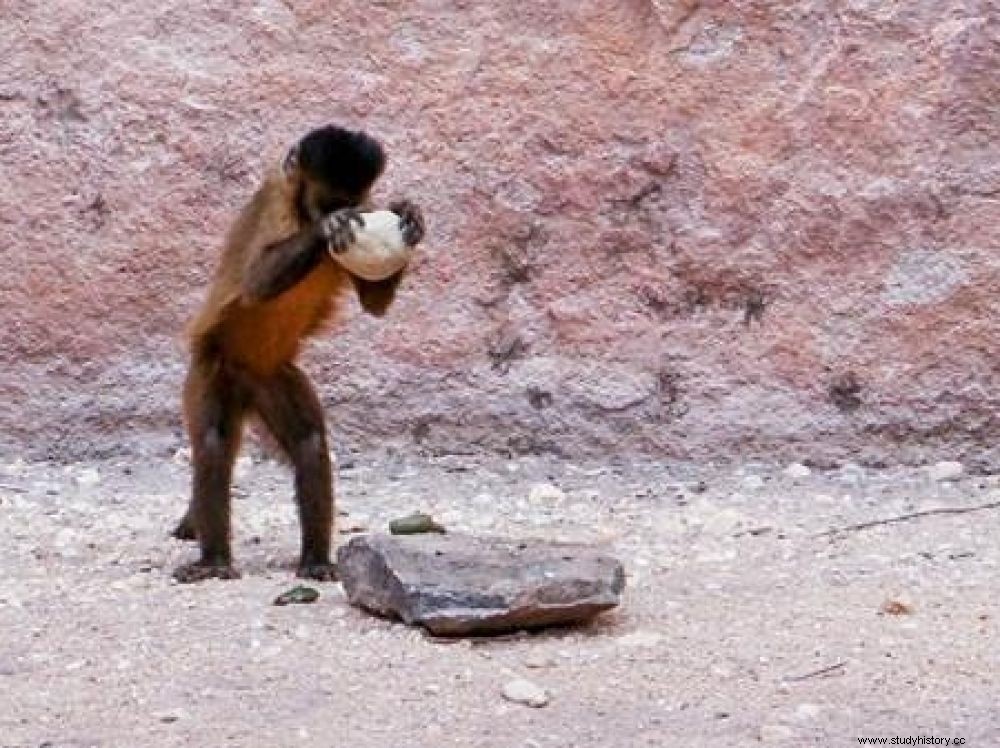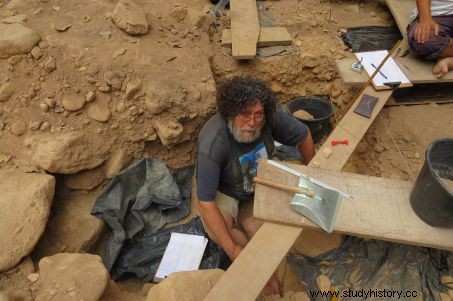The prehistorian Eric Boeda, a specialist recognized for his work on lithic industries, comes back with reservations on the recent announcements concerning Brazilian capuchin monkeys who cut tools...

A capuchin monkey using rocks, photographed in Serra da Capivara (Piaui) National Park, northeast Brazil.
Eric Boëda, professor at the University of Paris X - Nanterre, member of the Institut Universitaire de France, is notoriously known for his work on lithic industries, - the tools carved by prehistoric men -, which he studies on three continents. Director of an archaeological mission in Brazil, the expert returns to recent announcements concerning small capuchin monkeys which would unintentionally produce sharp shards of stone, resembling the tools of our ancestors… Behaviors which would therefore not be unique to the lineage human.

The prehistorian Eric Boeda, director of the French Archaeological Mission of Piaui, in Brazil. © Archaeological Mission of Piaui - Brazil
Sciences et Avenir:You work in northeast Brazil, in the region where, according to a recent article in the journal Nature published in October 2016, capuchin monkeys accidentally produced shards of stone, "resembling the tools of our ancestors". What did you think?
Eric Boëda: I actually work in the Serra Capivara National Park, in northeast Brazil, where these monkeys were filmed. This is a group of capuchins (Sapajus libidonosus ) very sociable, who is used to living near people. These monkeys are therefore not entirely wild, since the ethologists who study their behavior feed them and they sometimes come to steal our food. What makes me react is the ambiguous impression left by the Nature article. Reading it, one might think that these monkeys produced carved stones, as men would have done – even if it is specified that this is not intentional. While these Brazilian primates have only made silica dust, which they lick like goats or horses do with salt.
However, Do the videos show them using these stones?
Absolutely ! But there are several videos produced on these monkeys. But what exactly do we see there? In a film, it is monkeys who protect themselves from a jaguar by throwing stones at it to keep it away; in a second, a Capuchin takes a pebble to crush a grasshopper; finally, in another excerpt, the monkeys crack nuts using stones. In these three sequences, the monkeys did nothing other than use the mineral raw material for its mass and its hardness, and in no case to produce sharp objects!
One of the sequences, however, shows a capuchin ramming a block of quartz against a pebble rubble...
You are right. But when you smash one block against another - especially as frantically as those Capuchins do - one of the two blocks is bound to break. However, the fragments resulting from these fracturings are accidental. There is no intention. In the case of these sapajous, it is a waste of size related to the crushing of the blocks between them to obtain silica powder in order to ingest it. It should also be noted that it is the production of one and the same individual... And if we were to study the totality of his production, we would quickly realize that there has very few shards produced compared to the dozens of blocks used featuring crush surfaces, and the hundreds of hits this random Capuchin lands.
What distinguishes these flakes from those produced by man?
It is impossible to confuse the productions. When a shard is produced by man, a whole chain of transformations is associated with it to give it a function, obtaining for example an edge to scrape, or another to drill, etc. Arrangements and special cutting angles that are never present on the flakes found in nature, or in monkeys. However, the very fact that a monkey accidentally produces a cutting edge is not enough to draw conclusions about the conditions for the emergence of technology at the origins of humanity. Man anticipates his actions to produce precise forms that he can repeat identically as many times as he wishes. There is therefore no possible comparison with what these monkeys filmed in Brazil accidentally produced. If the animal world had discovered the principle of crushing using the hardness of mineral raw material, or its abrading and incising principle, then we would be living on the Planet of the Apes today! The tool is perhaps not specific to man, but what is specific to the human lineage, from the day when man knew how to use natural cutting edges, is to have them in constantly modified and transformed. Man has always produced difference, monkeys have not.
